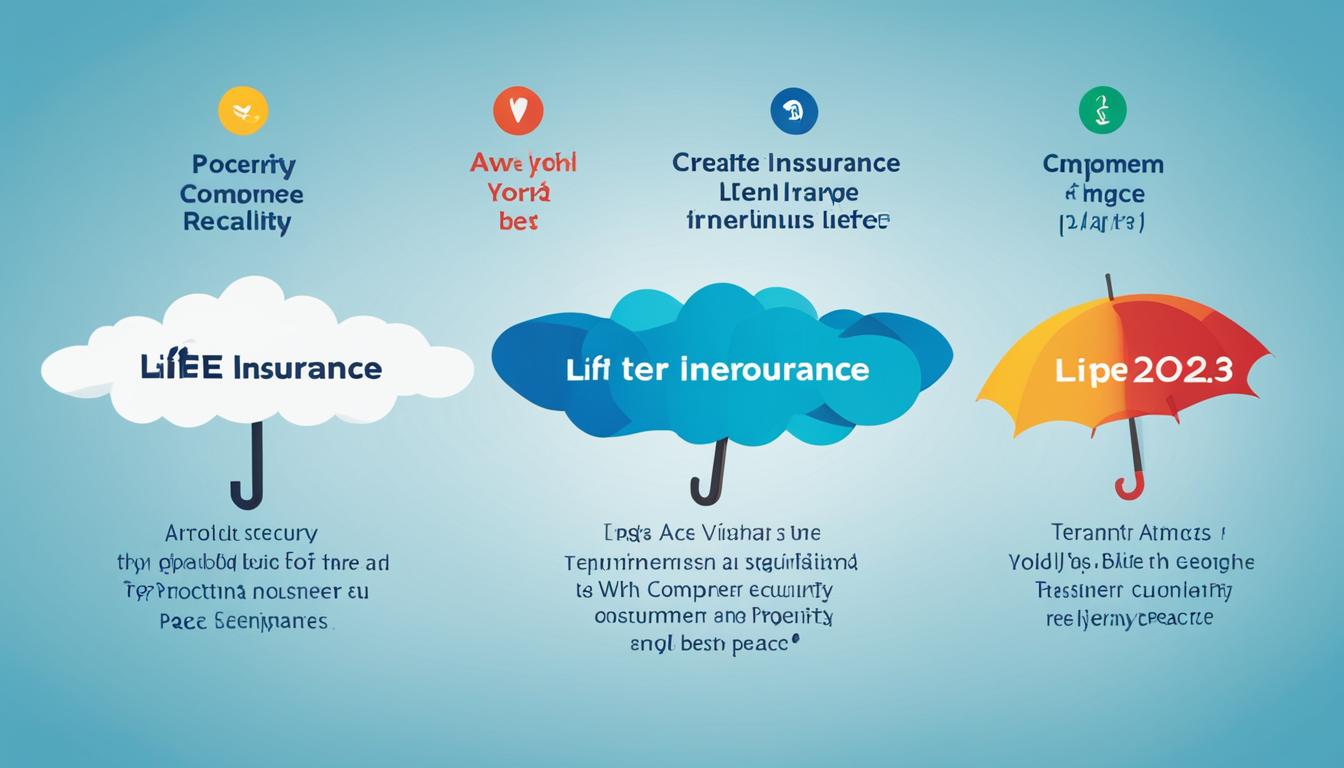Whole life insurance policy pros and cons is a popular type of permanent life insurance that offers lifelong coverage and a cash value component. It provides a guaranteed minimum rate of return on the cash value and pays out a guaranteed amount at the time of the insured’s death. However, whole life insurance can be more expensive compared to other types of life insurance policies, and policyholders cannot easily end the policy without incurring surrender charges.
Key Takeaways:
- Whole life insurance provides lifelong coverage and a cash value component.
- It guarantees a minimum rate of return on the cash value and pays out a guaranteed amount at the insured’s death.
- Whole life insurance can be more expensive compared to other types of life insurance policies.
- Policyholders may incur surrender charges if they decide to terminate the policy.
- Consider evaluating your financial needs and goals before deciding if whole life insurance is right for you.
What is Whole Life Insurance?
Whole life insurance is a type of permanent life insurance that provides lifelong coverage and includes a cash value component. This type of insurance offers coverage for the entire lifetime of the insured, as long as regular premium payments are made. It is designed to provide financial protection for loved ones and can also be used as a tool for wealth accumulation.
There are two main types of whole life insurance policies: non-participating and participating.
- Non-participating policies accumulate a guaranteed cash value over time.
- Participating policies have the potential to generate dividends based on the insurer’s performance.
Whole life insurance offers lifelong coverage, ensuring that beneficiaries receive a death benefit when the insured passes away. Additionally, it incorporates a cash value component that grows over time.
| Whole Life Insurance | ||
|---|---|---|
| Provides lifelong coverage | ||
| Grows a cash value component | ||
| Includes non-participating and participating options |
When considering whole life insurance, it is important to take into account the long-term financial goals and objectives. This type of insurance can provide both a death benefit and a cash value component which may offer individuals a well-rounded approach to financial planning and security.
How Does Whole Life Insurance Work?
Whole life insurance is a type of permanent life insurance that combines lifelong coverage with a cash value component. It provides policyholders with the security of knowing that their coverage will last for their entire life. But how does whole life insurance actually work?
When an individual purchases a whole life insurance policy, they make regular premium payments. These premium payments are used to fund both the death benefit and the cash value component of the policy. A portion of each premium goes towards building the cash value, which grows over time. The cash value is essentially a savings account within the policy that accumulates on a tax-deferred basis.
The policyholder has the option to access this cash value through policy loans or withdrawals. This can provide flexibility and financial assistance when needed. However, it’s important to note that any outstanding policy loans will reduce the death benefit available to beneficiaries upon the insured’s death.
Speaking of the death benefit, it is the guaranteed amount of money that the policy will pay out to the beneficiaries upon the insured’s death. The death benefit is usually tax-free and can provide financial protection to loved ones, helping to cover expenses such as funeral costs, outstanding debts, or ongoing living expenses.
Whole life insurance offers policyholders the peace of mind of knowing that their coverage is in place for their entire life, as long as they continue to make premium payments. Additionally, the cash value component of a whole life insurance policy can provide policyholders with a potential source of funds that can be accessed during their lifetime.
“Whole life insurance offers the dual benefits of lifelong coverage and a cash value component, making it an attractive option for individuals who want both protection and potential growth.”
In summary, whole life insurance works by providing policyholders with lifelong coverage and a cash value component. Premium payments contribute to both the death benefit and the growth of the cash value. The policyholder can access the cash value through loans or withdrawals, providing financial flexibility during their lifetime. In the event of the insured’s death, the policy pays out a guaranteed death benefit to the beneficiaries, providing financial protection for loved ones.
Key Features of Whole Life Insurance
| Key Features | Explanation |
|---|---|
| Lifelong Coverage | Provides coverage for the entire life of the insured as long as premium payments are made. |
| Cash Value Component | Accumulates over time and can be accessed through policy loans or withdrawals. |
| Death Benefit | Guaranteed amount paid out to beneficiaries upon the insured’s death. |
| Premium Payments | Regular payments made by the policyholder to maintain coverage. |

Benefits of Whole Life Insurance
Whole life insurance offers several benefits that make it an attractive option for individuals looking for lifelong coverage and financial security. Let’s take a closer look at the key advantages of whole life insurance:
Lifetime Coverage
One of the primary benefits of whole life insurance is that it provides lifetime coverage for the insured. Unlike term life insurance, which offers coverage for a specified period, whole life insurance ensures that your loved ones are protected for as long as you live. This can bring peace of mind, knowing that your family will be financially secure even after you’re gone.
Tax-Deferred Growth
Another advantage of whole life insurance is its ability to provide tax-deferred growth of the cash value. The cash value component of a whole life insurance policy accumulates over time and grows on a tax-deferred basis. This means that you won’t have to pay taxes on the growth of your policy’s cash value until you withdraw or borrow against it, allowing your money to potentially grow faster over the long term.
Access to Cash Value
Whole life insurance policies also offer access to cash value, which can be valuable in times of need. You can access the cash value through policy loans or withdrawals, providing you with financial flexibility and convenience. Whether you need to cover an unexpected expense or fund a large purchase, having access to your policy’s cash value can help you meet your financial goals.
Accelerated Benefits
One unique feature of whole life insurance is its ability to provide accelerated benefits. If you develop a critical illness or need long-term care, some whole life insurance policies offer accelerated benefits, allowing you to receive a portion of the death benefit while you’re still alive. This can provide financial assistance during challenging times, helping you cover medical expenses or other costs associated with your condition.
Benefits of Whole Life Insurance
| Benefit | Description |
|---|---|
| Lifetime Coverage | Provides coverage for the entire lifetime of the insured |
| Tax-Deferred Growth | Cash value grows on a tax-deferred basis, potentially accelerating wealth accumulation |
| Access to Cash Value | Policyholders can access the cash value through loans or withdrawals |
| Accelerated Benefits | Enables policyholders to receive a portion of the death benefit if they develop a critical illness |
These benefits highlight the advantages of whole life insurance and its potential to provide lifetime coverage, tax advantages, access to cash value, and additional financial support when needed. However, it is essential to carefully evaluate your financial goals and needs to determine if whole life insurance aligns with your specific circumstances.

Disadvantages of Whole Life Insurance
While whole life insurance offers lifelong coverage and a cash value component, it also comes with a few disadvantages to consider.
1. Expensive Premiums
One significant disadvantage of whole life insurance is the higher cost compared to other types of life insurance. Premiums for whole life policies can be up to 15 times more expensive for the same death benefit. This expense can make whole life insurance less affordable for some individuals.
2. Surrender Charges
If the insured decides to terminate the whole life insurance policy, surrender charges may apply. These charges are imposed to compensate the insurance company for the costs incurred in issuing and administering the policy. Surrender charges can hinder the policyholder’s ability to exit the policy without incurring financial penalties.
3. Reduction of Death Benefit
Accessing the cash value of the whole life insurance policy through loans or withdrawals can result in a reduction of the death benefit. This reduction can impact the financial protection that the policy provides to the beneficiaries, potentially leaving them with a lower payout compared to the original death benefit amount.
In summary, whole life insurance’s expensive premiums, surrender charges, and the reduction of death benefit through cash value access are important factors to consider when evaluating this type of insurance policy.

Difference Between Whole Life Insurance and Term Life Insurance
When considering life insurance options, it’s essential to understand the differences between whole life insurance and term life insurance. These two types of policies vary in terms of coverage period, premium prices, and the presence of a cash value component. Here’s a breakdown of each:
Whole Life Insurance
Whole life insurance provides lifetime coverage, meaning it offers protection for as long as the policyholder lives as long as premium payments are made on time. This type of insurance guarantees a death benefit payout to the beneficiaries upon the insured’s passing. Additionally, whole life insurance policies accumulate a cash value over time, which grows tax-deferred and can be accessed through policy loans or withdrawals.
Term Life Insurance
Term life insurance, on the other hand, covers the insured for a specific term or duration, such as 10, 20, or 30 years. If the insured passes away during the term, the policy will pay out the death benefit to the beneficiaries. Unlike whole life insurance, term policies do not accumulate cash value over time. However, term life insurance is often more affordable, with lower premium prices compared to whole life insurance.
Differences at a Glance:
| Whole Life Insurance | Term Life Insurance | |
|---|---|---|
| Coverage Period | Lifetime | Specified Term (e.g., 10, 20, 30 years) |
| Premium Prices | Higher | Lower |
| Cash Value | Accumulates over time | No cash value component |
It’s important to carefully consider your needs and financial goals when choosing between whole life insurance and term life insurance. Whole life insurance offers lifetime coverage and the potential for cash accumulation but comes with higher premium prices. Term life insurance, on the other hand, provides coverage for a specified term at more affordable rates. Evaluate your circumstances and consult with a financial advisor or insurance professional to determine the best option for you and your loved ones.

Difference Between Whole Life Insurance and Universal Life Insurance
Whole life insurance and universal life insurance are two popular types of permanent life insurance policies. While both offer lifelong coverage and a cash value component, there are key differences between them in terms of premium flexibility and cash value growth.
Premium Flexibility
One significant difference between whole life insurance and universal life insurance is the flexibility of premiums. Whole life insurance has fixed premiums, meaning the policyholder pays the same premium amount throughout the life of the policy. This can provide stability and predictability in budgeting for insurance costs.
On the other hand, universal life insurance allows policyholders to adjust their premium payments within certain limits. This flexibility can be advantageous for those who want to pay higher premiums during periods of financial abundance or lower premiums during times of financial constraint. It offers a more dynamic insurance option that can adapt to changing financial circumstances.
Cash Value Growth
Another significant difference is how the cash value of the policies grow. In whole life insurance, the cash value component guarantees a minimum rate of return. This means that the cash value of the policy grows over time, regardless of how the market performs. The policyholder is assured that their cash value will increase steadily over the life of the policy.
Universal life insurance, on the other hand, does not guarantee a minimum rate of return for the cash value growth. The performance of the policy’s cash value is tied to the market, similar to an investment. While there is potential for higher returns, there is also the risk of lower or negative growth depending on the market conditions.

Summary Comparison
| Aspect | Whole Life Insurance | Universal Life Insurance |
|---|---|---|
| Premiums | Fixed premiums | Flexible premiums within limits |
| Cash Value Growth | Guaranteed minimum rate of return | Tied to market performance |
It is important for individuals to carefully consider their financial goals and risk tolerance when choosing between whole life insurance and universal life insurance. Whole life insurance offers stability and guaranteed growth, while universal life insurance provides flexibility and potential for higher returns. Consulting with a financial advisor can help determine which option aligns best with an individual’s specific needs and circumstances.
Cost of Whole Life Insurance
When considering whole life insurance, it’s important to understand the cost associated with this type of policy. Whole life insurance premiums are typically higher compared to other types of life insurance policies. The cost of whole life insurance is influenced by several factors, including:
- Age: The younger you are when you purchase a whole life insurance policy, the lower your premiums are likely to be.
- Health: Insurance companies consider your health when determining the cost of your premiums. If you have pre-existing health conditions, you may pay higher premiums.
- Desired Death Benefit: The amount of coverage you choose will also impact the cost of your premiums. The higher the death benefit, the higher your premiums.
It’s important to note that most whole life insurance policies operate with level premiums. This means that the premium rates remain the same for the duration of the policy. Level premiums offer stability and predictability, allowing policyholders to plan their financial commitments accordingly.
Also Read:- Life Insurance Whole Life: Secure Your Family’s Future
When evaluating the cost of whole life insurance, it’s necessary to consider your financial situation and long-term goals. While whole life insurance offers lifelong coverage and a cash value component, the higher premiums associated with this type of policy may make it less affordable for some individuals. It’s recommended to speak with a financial advisor or insurance professional to assess your specific needs and determine if whole life insurance is the right fit for you.
Cost Factors of Whole Life Insurance
| Factors | Impact on Premiums |
|---|---|
| Age | Younger age correlates with lower premiums. |
| Health | Pre-existing health conditions can increase premiums. |
| Desired Death Benefit | Higher death benefit results in higher premiums. |
Riders for Whole Life Insurance Policies
Whole life insurance policyholders have the option to enhance their coverage with various riders. These riders provide additional benefits and coverage options to customize the policy according to specific needs. Let’s take a closer look at two common riders available for whole life insurance policies:
Accidental Death Benefit Rider
One popular rider is the Accidental Death Benefit Rider. This rider offers an additional death benefit if the insured dies as a result of an accident. It provides an added layer of financial protection for unexpected events, ensuring that loved ones receive an increased benefit in case of accidental death. The Accidental Death Benefit Rider can be an essential feature for individuals working in high-risk occupations or those who engage in activities with inherent dangers.
Long-Term Care Rider
Another valuable rider is the Long-Term Care Rider. This rider provides coverage for long-term care expenses, such as nursing home care, assisted living, or home healthcare services. It ensures that policyholders have access to the necessary funds to cover the substantial costs associated with long-term care. The Long-Term Care Rider provides peace of mind, knowing that the financial burden of extended healthcare needs can be alleviated.
These are just two examples of the additional coverage options available through riders for whole life insurance policies. There may be other riders offered by insurance companies, depending on their product offerings and the needs of their customers. It’s essential to review and consider the available riders during the whole life insurance policy selection process to tailor the coverage to individual circumstances.
Is Whole Life Insurance Worth It?
When considering whole life insurance, it’s essential to evaluate its worth based on your individual financial needs and goals. Whole life insurance can serve as a valuable financial tool, providing benefits such as coverage for dependents and the potential for cash accumulation. With its lifelong coverage, this type of policy offers a sense of security and ensures that your loved ones are protected even after you’re gone. Additionally, the cash value component of whole life insurance can be an effective way to accumulate wealth over time.
One of the key advantages of whole life insurance is its potential for tax-deferred cash accumulation. As you make regular premium payments, a portion of these payments goes towards building the policy’s cash value. This cash value grows over time, providing you with a savings component that can be accessed through policy loans or withdrawals. This can be particularly appealing for individuals who want a long-term financial strategy that includes saving and investing.
Whole life insurance provides coverage for dependents and serves as a financial tool for cash accumulation. It offers the potential for tax-deferred growth, providing individuals with an opportunity to build wealth over time. It’s a lifelong commitment that can provide both protection and financial security.
However, it’s important to consider the cost of whole life insurance. The premiums associated with whole life policies tend to be higher compared to other types of life insurance. The increased cost may make it less affordable for some individuals, especially those who are on a tight budget or have other financial obligations to consider. Before committing to a whole life insurance policy, it’s crucial to assess your financial situation and determine if the premiums align with your ability to pay.
In summary, whole life insurance can be a worthw ile consideration for individuals who are looking for lifelong coverage, cash accumulation, and a financial tool to protect their loved ones. It provides coverage for dependents and has the potential for tax-deferred growth. However, it’s important to carefully evaluate the associated premiums to ensure that they fit within your budget. By considering your financial goals and needs, you can make an informed decision about whether whole life insurance is the right choice for you.
Can You Cash Out a Whole Life Insurance Policy?
Whole life insurance policies come with a cash value component that provides some flexibility to policyholders. If you find yourself in need of funds, there are two main options for accessing the cash value: policy loans and policy surrender.
Policy Loans: With a policy loan, you can borrow against the cash value of your whole life insurance policy. This option allows you to access the funds without surrendering the policy. Keep in mind that the loan amount will accrue interest, which will need to be repaid. Failure to repay the loan may result in a reduction of the policy’s death benefit.
Policy Surrender: If you no longer need the coverage provided by your whole life insurance policy, you can choose to surrender the policy. Surrendering the policy means you terminate the coverage and receive the cash value minus any surrender charges. It’s important to evaluate the surrender charges carefully before making a decision, as they can significantly impact the amount you receive.
Before considering either option, it’s crucial to assess your financial situation and long-term needs. Cashing out a whole life insurance policy should only be done if you no longer require the coverage or have alternative life insurance arrangements in place. Make sure to consult with your insurance advisor before proceeding.
Conclusion
In evaluating whether a whole life insurance policy is the right choice for you, it’s important to consider the pros and cons. Whole life insurance offers lifelong coverage and a cash value component, providing stability and potential financial growth. However, it’s crucial to acknowledge that whole life insurance policies generally come with higher premiums compared to other types of life insurance.
Before making a decision, take the time to assess your individual financial needs and goals. Determine if the benefits of whole life insurance, such as guaranteed coverage and tax-deferred growth, outweigh the higher cost. Additionally, carefully consider the potential drawbacks, including surrender charges and the impact of accessing cash value on the death benefit.
Ultimately, choosing the right life insurance policy requires an in-depth evaluation of your long-term financial plans. Consider consulting with a trusted financial advisor or insurance professional to ensure that your decision aligns with your unique circumstances and goals.
FAQs
Q: What is whole life insurance?
A: Whole life insurance is a type of permanent life insurance that provides lifelong coverage and a cash value component.
Q: How does whole life insurance work?
A: Whole life insurance works by providing lifelong coverage and a cash value component. The insured pays regular premium payments, a portion of which goes towards the policy’s savings component, allowing it to accumulate cash value over time. In the event of the insured’s death, the policy pays out a guaranteed death benefit to the beneficiaries.
Q: What are the benefits of whole life insurance?
A: Whole life insurance offers lifetime coverage, guaranteed tax-deferred growth of the cash value, and access to cash value through loans or withdrawals. It also provides accelerated benefits for critical illness and can be used as a financial tool to accumulate wealth.
Q: What are the disadvantages of whole life insurance?
A: One disadvantage of whole life insurance is the higher cost compared to other types of life insurance. Premiums for whole life policies can be up to 15 times more expensive for the same death benefit. Another disadvantage is the imposition of surrender charges if the insured decides to terminate the policy. Additionally, accessing the cash value through loans can result in a reduction of the death benefit.
Q: What is the difference between whole life insurance and term life insurance?
A: Whole life insurance provides lifelong coverage, while term life insurance covers the insured for a specified term. Premiums for term life insurance tend to be lower, but term policies do not accumulate cash value like whole life policies.
Q: What is the difference between whole life insurance and universal life insurance?
A: Whole life insurance has fixed premiums, while universal life insurance allows policyholders to adjust premiums within certain limits. The cash value in whole life insurance guarantees a minimum rate of return, while universal life insurance’s cash value growth depends on how the market performs.
Q: How much does whole life insurance cost?
A: Whole life insurance premiums can be more expensive compared to other types of life insurance policies. The cost of whole life insurance is influenced by factors such as the insured’s age, health, and desired death benefit. Most whole life policies operate with level premiums, meaning the rates remain the same for the duration of the policy.
Q: What are riders for whole life insurance policies?
A: Riders for whole life insurance policies provide additional coverage options. Common riders include accidental death benefit riders, which provide an additional death benefit if the insured dies due to an accident, and long-term care riders, which provide coverage for long-term care expenses.
Q: Is whole life insurance worth it?
A: Whether whole life insurance is worth it depends on individual financial needs and goals. Whole life insurance can be a valuable financial tool for accumulating wealth and providing coverage for dependents. It offers lifetime coverage and the potential for tax-deferred cash accumulation. However, the higher premiums associated with whole life insurance may make it less affordable for some individuals.
Q: Can you cash out a whole life insurance policy?
A: Whole life insurance policies have a cash value component that can be accessed through policy loans or withdrawals. Policyholders can borrow against the cash value or surrender the policy to receive the cash value minus any surrender charges. It’s important to note that surrendering the policy terminates the coverage, so it should only be done if the policyholder no longer needs the coverage or has alternative life insurance.
Q: How do I evaluate a whole life insurance policy?
A: When evaluating a whole life insurance policy, consider the benefits and drawbacks of whole life insurance and whether it aligns with your long-term financial plans. Assess your financial needs and goals, review the policy’s premiums, cash value growth, and additional features such as riders. It may be helpful to consult with a licensed insurance agent to guide you in the evaluation process.
Q: What type of coverage does whole life insurance offer?
A: Whole life insurance offers lifelong coverage for the insured. It provides a guaranteed death benefit to the beneficiaries upon the insured’s death, as long as regular premium payments are made.
Q: What are the pros and cons of whole life insurance?
A: The pros of whole life insurance include the guaranteed death benefit, cash value accumulation, and a fixed premium. However, the cons involve higher premiums compared to term life insurance and less flexibility in investment options.
Q: Is whole life insurance worth buying?
A: Whether whole life insurance is worth buying depends on your individual financial situation and long-term goals. It may be suitable for those seeking permanent coverage with cash value accumulation, but it’s essential to carefully consider the cost and benefits.
Q: How does whole life insurance differ from term insurance?
A: Whole life insurance provides coverage for the policyholder’s entire life, while term insurance covers a specific period. Additionally, whole life insurance builds cash value over time, whereas term insurance does not offer this feature.
Q: Can whole life insurance be considered an investment?
A: Yes, whole life insurance can be viewed as an investment due to its cash value accumulation and potential for long-term growth. However, it’s important to weigh the investment aspect against other available investment options.
Q: What are the advantages and disadvantages of whole life insurance?
A: The advantages of whole life insurance include lifelong coverage, cash value growth, and fixed premiums. On the other hand, the disadvantages revolve around higher premium costs and potentially lower investment returns compared to alternative investment options.
Q: Are there any drawbacks to whole life insurance?
A: One drawback of whole life insurance is the higher cost compared to term insurance. Additionally, policyholders have limited flexibility in adjusting premium payments or investment options, which can be considered a downside.
Q: How do whole life insurance companies differ from term life insurance companies?
A: Whole life insurance companies focus on providing permanent policies with cash value accumulation, while term life insurance companies primarily offer coverage for a specific term without any cash value component.
Q: Why should someone consider buying whole life insurance?
A: Individuals may consider buying whole life insurance for its lifelong coverage, cash value accumulation, and potential to serve as an inheritance or estate planning tool for beneficiaries.
Q: Is whole life insurance a good option for meeting long-term insurance needs?
A: Whole life insurance can be a suitable option for meeting long-term insurance needs, especially for those seeking permanent coverage and the ability to accumulate cash value over time.
Q: Does whole life insurance offer investment options?
A: Yes, whole life insurance offers investment options through the cash value component, allowing policyholders to potentially grow their money over the policy’s lifetime.




